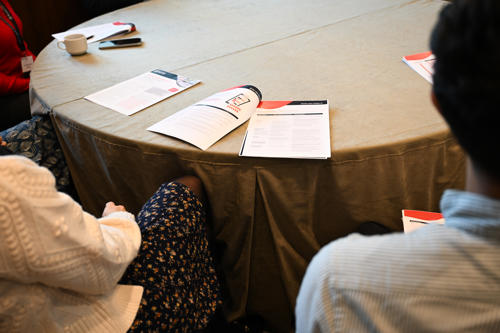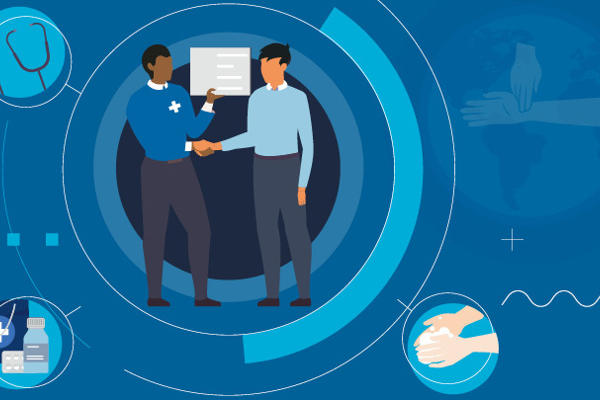In November 2024, the RCP launched its an acute care toolkit on Managing multiple medications. This valuable toolkit aims to help doctors in hospital with tackling overprescribing.
Dr Cleodie Swire, our resident doctor guest editor, spoke to three of the toolkit’s authors: Dr Lucy Pollock (LP), a consultant geriatrician at Somerset NHS Foundation Trust, Dr Tessa Lewis (TL) a GP with an interest in therapeutics and frailty, and Dr Laurence Gray (LG), a consultant clinical pharmacologist and toxicologist working in Cardiff and Vale University Health Board.
Why is managing medicines something that all NHS physicians should care about?
LP: At least one in 10 – probably one in five – acute medical admissions of people over the age of 65 is caused by a problem with medications. If we said that one in five surgical admissions was due to a problem with the previous surgery, we would be up in arms.
Life is complicated and many patients have multiple conditions, so prescribing has become a dense patch of thorns. That means that prescribers need help, good training and support in getting medications right.
TL: The 2023 chief medical officer’s annual report reminded us that sometimes we need fewer medicines, rather than more. There aren’t many opportunities like this in the NHS. You can improve patients’ wellbeing, reduce harm and reduce waste. It's one of those rare opportunities where you have a win–win..
LG: Managing medications is a great way to empower patients. We have to make sure that any treatment that we give is tolerable and actually helps the patient. It goes back to ‘first, do no harm’. We have a responsibility to look after and respect our patients. Making decisions around their care, rather than just giving another medication, is key to that. This drives a stronger patient–clinician relationship, which is fundamental to our practice.
LP: One thing I say to resident doctors is ‘a prescribing pad is my knife’. It's my equipment, my equivalent of a surgeon’s knife. So, I should think as carefully about prescribing as a surgeon would about an operation. This is my intervention; it’s so important to get it right.
This also relates to cost and waste. There's an extraordinary statistic extraordinary statistic that about 20% of all healthcare activity globally is of no value to the patient. A huge amount of that will be unnecessary and wasted prescriptions. Imagine the environmental effect and financial cost to the NHS. We have a moral duty to address that, as well as a medical duty.

Dr Tessa Lewis at Med+ 2024
What are the main harms from problematic polypharmacy?
LG: Problematic polypharmacy is when medications that are no longer appropriate are potentially causing harm. The more you take, the higher the risk.
This may be due to a >prescribing cascade; patients have adverse effects, then to counteract these side effects they are prescribed more medications. This leads to a vicious circle. We need to think about the root cause [of symptoms] and consider medications when doing so.
LP: The big hitters for geriatricians include medications that cause falls, constipation and confusion. Then there are the hidden, long-term downsides of some medications – like chronic use of a proton pump inhibitor increasing your risk of osteoporosis. Another factor is anticholinergic burden; we now know that we’re prescribing anticholinegic medications associated with a 10–20% increase in dementia risk.
What is the impact for the patient? They have to take their five, 12, 18 different medications every day; collect them from the pharmacist, remember which to take before or after breakfast, which they can’t take with tea, coffee or grapefruit juice … It’s a very dominant part of life. Most older people do not want to spend this extraordinary amount of time every day dealing with the complexities, anxieties and sheer burden of managing that many medications.
LG: As the number of medications a patient takes increases, it is likely that their understanding decreases. This disempowers the patient, and they become more passive in their healthcare.
TL: I agree. People are struggling to understand what they’re taking now in a way that they didn’t 10 years ago, because of the sheer number of medications.
'From a positive angle, you are making the most enormous difference when you get prescribing right. It makes a patient happy; almost every patient will say ‘yes please’ to cutting down on medications. They will feel better, safer and happier. It’s a rewarding exercise.'
Consultant geriatrician
Dr Lucy Pollock
LP: It is all about balance. We don’t want to force people to be responsible for their medication, as it is complicated.
At the same time, they need the information to make an informed choice about their medications. That’s the direction we want this toolkit to help doctors take; empowering patients, but making it our responsibility to get this right, not theirs.
What are the main aims of the Managing multiple medications toolkit?
TL: ‘Think medicines!’ It’s an opportunity for doctors to check their thought process, it includes lots of ideas and resources. It encourage us to ‘think medicines’ when seeing patients, including recognising medicines-related harms.
LG: Addressing polypharmacy can be daunting. This toolkit gives an ‘on the shop floor’ approach; you pick advice that is appropriate for your time and resources. If you can’t do a full medications review, you could use the APINCHS tool to screen for high-risk medications.
LP: The toolkit provides lots of useful links and tools to improve prescribing. It doesn’t do the job for you, it doesn’t tell you which drugs to stop or start. What it does is give teams and individuals ways of improving their practice. Different people will find different tools useful.
Pharmacology is a complicated field. With competing pressures in medical school curricula, some prescribing knowledge is learnt on the job – which can feel very overwhelming for resident doctors. Physicians already practising must stay abreast of emerging medications. Anything that helps confidence in prescribing can be valuable.
Once you get your head around managing medicines well, it quickly becomes pattern recognition. You learn to read a drug chart and become familiar with the common problems; certain drugs leap out, you see obvious interactions and ones you need to question. This toolkit is partly to help build confidence quickly.

Dr Lucy Pollock at Med+ 2024
Can you give examples of how you implemented the toolkit approaches to address polypharmacy?
LG: I always think of medicines as a potential cause when looking at the patient’s presenting features. Get up the drug chart and actually look at the medications when you see a patient.
I use a simple question about whether they are taking their medications as a starting point. From that you can understand the relationship that the patient has with their medications. Question what the medications are, and why they are prescribed. Screen for any APINCHS drugs, to ensure that the most high-risk medications are being used appropriately. What I have suggested is not resource intensive.
LP: Two tools that I use are GP Evidence and BRAN.
GP Evidence is a fantastic shared decision-making tool. It shows a patient or their family – and doctors – the benefits and downsides of a medication.
BRAN helps you frame conversations, such as when we’re choosing whether to prescribe anticoagulation for somebody with atrial fibrillation who is frail and falls often. Doctors often calculate a CHA2DS2-VASc score, then prescribe anticoagulation. But what are the benefits, the risks, the alternatives? What happens if you do nothing?
TL: I often use Medichec. Not only does this assess anticholinergic effect, but it visually summarises other risks such as hyponatraemia, dizziness and drowsiness. The toolkit also has a table which is useful when assessing patients with common symptoms – like hallucinations, agitation or falls – and makes it easy to determine which medications might be contributing.
The toolkit says that ‘continuation of prescription is an “active” act’. What advice do you have for clinicians making decisions about chronic medications in an overstretched acute setting?
TL: It is really difficult in that acute emergency setting. At a minimum, consider what drugs might be contributing to the presentation. If a patient is admitted, you have an opportunity to really look at their medicines; to question whether they’re still needed and should be continued. By the time you get to writing the discharge summary, then it is too late to start.
LG: Some of these discussions can require a bit of time, so a good approach is to highlight a medicine as a potential issue in the patient’s notes – which may allow it to be addressed later on in the admission. Patients are handed between multiple hospital teams now, so it’s crucial to document our thought processes for the teams taking over care, which can include reviews of medications.
LP: My advice is to prioritise medications. This is key information, it isn't a sideline in medicine. This is a core part of being a physician. Give it the attention it deserves.
If you were a surgeon, you would be proud that you can do a laparoscopic cholecystectomy on your own. When you encounter an unfamiliar drug or side effect, look it up. This information is not innate. Grow your knowledge, be proud of growing your knowledge. If you can read a drug chart with 12 different medicines that you’re familiar with, that’s training to be proud of.
LG: As a consultant, it’s really important to be seen, within the healthcare team, to consult resources. Demonstrating that it’s the safe thing to do goes a long way to encouraging medicine safety; you set an example and it opens up conversations. Misplaced pride can become a cultural problem.
With specialised medications, such as oncology treatments, there is a danger that they are not recognised as the cause of acute issues. The key is to always consider them and seek further guidance from specialist colleagues.
Another quote from the toolkit is ‘don’t diss your predecessors’. How do you address polypharmacy without undermining the original prescriber and affecting the patient’s trust in clinicians?
LG: I think this is a good motto in general for medical care. The key thing to remember is that things are dynamic. My approach is, ‘This medication may have been good, but at this time, there’s not much benefit from it and it may be causing some harm’.
LP: Sometimes it’s worth proactively warning patients that things may change. I often say to older people with heart failure that their body will change, and that means medications will too. It’s not just about avoiding undermining other clinicians; patients can end up feeling guilty or frustrated that they’ve been taking a useless medicine all this time.
TL: I will often refer to the change in evidence. For example, aspirin was prescribed for patients with hypertension for primary prevention of cardiovascular disease – but the NICE guidance changed. If there are changes such as declining renal function or body weight, it can be helpful to share the rationale.
LG: Transition of care communication is crucial. If medication changes are not communicated to the primary care team, the patient may well end up back on those medications.
'A key part of this is communication. Something that can affect the patient’s trust in clinicians is when one doctor stops a medication, another restarts it, then it’s stopped again … The rationale needs to be explained to patients and other healthcare professionals, so that it can inform subsequent discussions.'
Dr Laurence Gray
Consultant clinical pharmacologist and toxicologist
What projects would you recommend for clinicians trying to assess or improve the management of medicines in their working environment?
LP: There are excellent related audit and quality improvement projects available. There may be a tool that you could encourage your team to use and then see whether that improves practice.
There’s lots in this toolkit, so people can choose what they’re most interested in. I’d start with the quality of discharge information. I think that's a lovely subject to audit; for every drug that has been stopped, has the reason for discontinuation been included? If you can work with your IT team to mandate a reason for discontinuation, that could be a fabulous change.
Projects that give the patients a voice can be useful; maybe an audit about whether patients understand their medicines before going home.
LG: Simple projects work well! You could look at antimicrobials; were the duration and indication documented?
TL:Drug huddles, or ‘druggles’, have been set up in some departments; short multidisciplinary team sessions once a week to talk about what medicine-related issues they’ve seen and identify learning points. I think this is a nice example of collaborative working and prioritising medicines, which people may be interested to trial on their wards.

Read the Managing multiple medications toolkit on the RCP website – and take a look at the rest of our clinical resources which can help support your practice.






